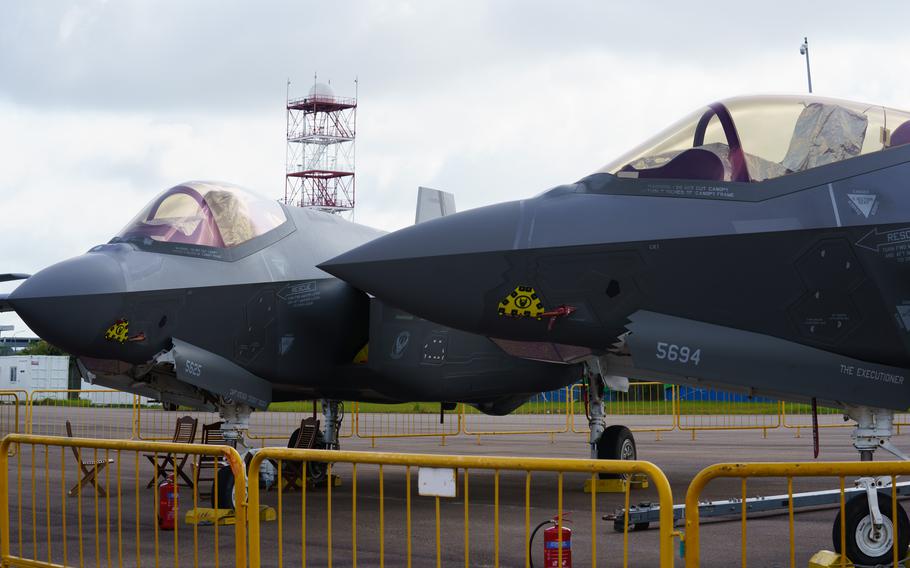
A declassified Pentagon comprehensive test report of Lockheed Martin’s F-35 warplane, reveals that six years of combat testing has been marred by reliability and maintenance delays, guns that don’t shoot straight and unresolved concerns about cyber defense capabilities. (Ore Huiying/Bloomberg)
(Tribune News Service) — A declassified Pentagon comprehensive test report of Lockheed Martin Corp.’s F-35 warplane, America’s most expensive weapons system, reveals that six years of combat testing has been marred by reliability and maintenance delays, guns that don’t shoot straight and unresolved concerns about cyber defense capabilities.
“The overall reliability, maintainability and availability of the US fleet remains below service expectations,” the Director of Operational Test and Evaluation said in a redacted version of the February report, which was obtained by the Washington-based Project on Government Oversight through the Freedom of Information Act.
The organization plans to release it Thursday.
The report discloses enough troubling nuggets that the incoming Trump administration would likely want a total review of the unredacted report’s outline of readiness, maintenance and logistics headaches, according to Greg Williams, POGO’s Center for Defense Information director.
“The Trump administration should bear in mind we’ve been flying the F-35 for 18 years and we still can’t maintain it, keep its stealth skin intact or shoot its gun straight,” Williams said in a statement.
The Heritage Foundation’s Project 2025, which has been seen as a possible blueprint for the new administration though Trump himself disavowed it, called for increasing the Air Force’s annual procurement of the F-35A variant to between 60 and 80, up from a planned 48.
“There were times when the planned aircraft were not available because required repairs had not been completed or because spare parts were not available,” the test office said. At other times, aircraft had failures after takeoff before planned tests could even begin, it said.
Overall, “fewer aircraft were deployed and fewer sorties flown than planned due” maintenance and reliability shortfalls that affected aircraft suitability, it said.
Despite the issues, the Pentagon in March allowed the program to proceed a “full-rate production,” a key statement of confidence but a largely symbolic move because Lockheed was already assembling jets at that pace.
That decision came about a month after the 382-page report was fully classified, including its introductory letter to Secretary of Defense Lloyd Austin. The Defense Department estimates the program will cost more than $1.8 trillion over the course of its life cycle, including development, production and sustainment.
The Pentagon F-35 program office said in a statement that “we have combat capable aircraft in operation today and they perform exceptionally well against the threat for which they were designed. Pilots continually emphasize that this is the fighter they want to take to war if called upon.”
“The readiness impact to the test fleet experienced during operational test was not new or unknown,” the office added, saying that it “continues working to improve” reliability and availability.
Lockheed Martin in a statement said the F-35 “consistently meets or exceeds the reliability performance requirements we are contracted to deliver” as “almost 90% of F-35 components are performing better than required.”
“We are investing more than $350 million in our engineering developmental systems integration test capabilities to create capacity and efficiency for the program to learn earlier” in the process, the company said.
Problems identified in the report include:
• The aircraft’s system for automatically diagnosing faults sent false alarms at a rate of one per hour, against a requirement of one per 50 hours.
• The F-35 “takes at least twice as long to repair as required” compared to its formal requirements in part because the “poor failure rate of critical parts was a significant contributor to low availability” for missions and “the critical failures are relatively evenly spread out among many different components.”
• Jets often flew test missions with their stealthy exterior coatings, technically known as “low observable,” in need of repair. “Maintenance such as low-observable system restoration was frequently deferred to allow aircraft to continue to fly,” the report said. None of the Air Force and Navy models performed missions while fully stealthy.
• The 25mm cannon mounted on the F-35 Air Force variant failed to hit targets “because of design and installation issues” despite years of remediation efforts.
• Details on the F-35’s ability to withstand cyber attacks on its 24 most-sensitive systems were redacted, although an unredacted portion said “the knowledge of actual aircraft vulnerability is limited” and urged the program office to provide a jet “that allows for full, end-to-end testing in a representative cyber threat environment.”
• The F-35 is designed to fight the world’s most advanced, “5th Generation” fighters such as those fielded by China but “in only one trial was a 5th Generation adversary aircraft used.”
• Air Force and Marine Corps jets required an excessive “logistics footprint” of support equipment and spare parts to deploy overseas to land bases or amphibious vessels.
Regarding the cyber threats, the program office said they were “dynamic and thus require agile defense in depth” and that it maintains one of the most robust cybersecurity testing programs in the Defense Department.
Lockheed said “we have also made significant investments in countering cyber security threats, and we remain confident in the integrity of our robust, multi-layered information systems security.”
In the beginning of his first term, Trump slammed the program for “the tremendous cost and cost overruns” and publicly speculated whether rival Boeing Co. could produce a comparable version of its F/A-18 Super Hornet. Then-Defense Secretary Jim Mattis ordered a cost-comparison study of the two jets, but that was never released.
The US has so far contracted for at least 881 of an expected 2,456 jets. Over 1,000 of the fighters for the US and overseas buyers, out of an expected eventual 3,000, have been delivered.